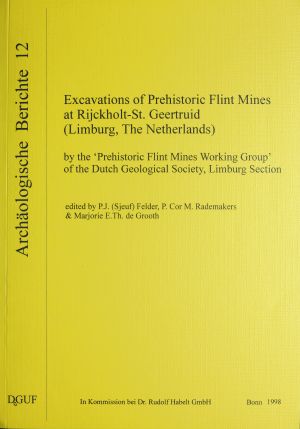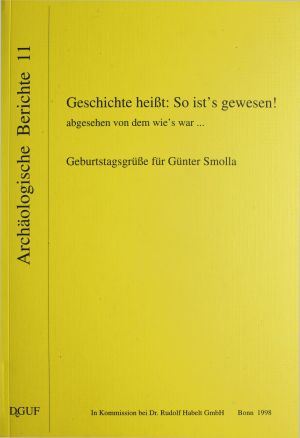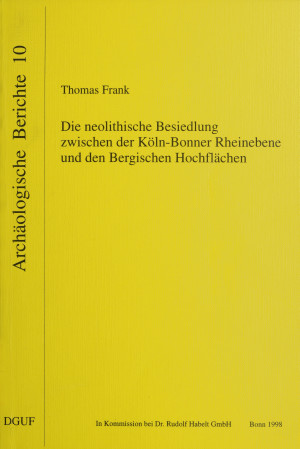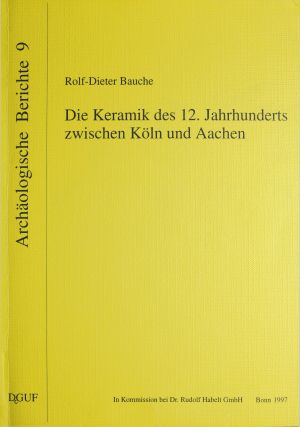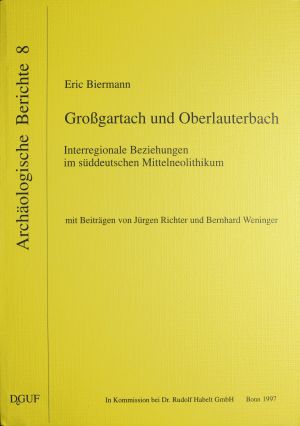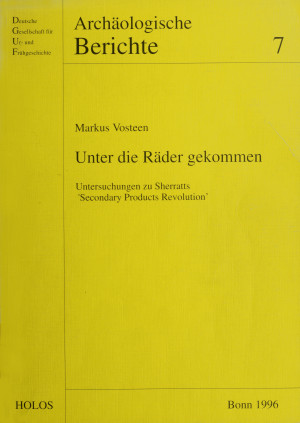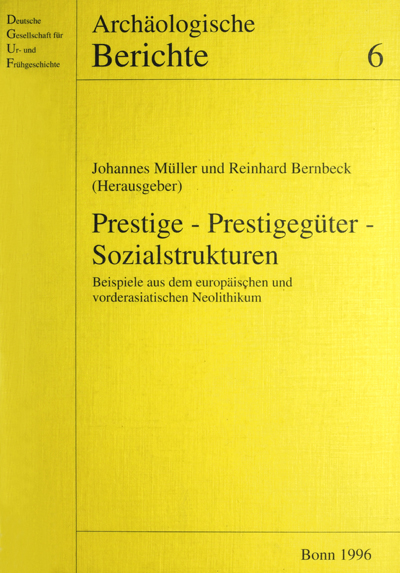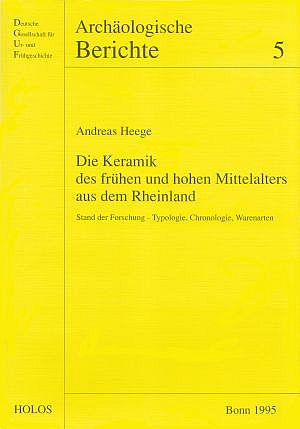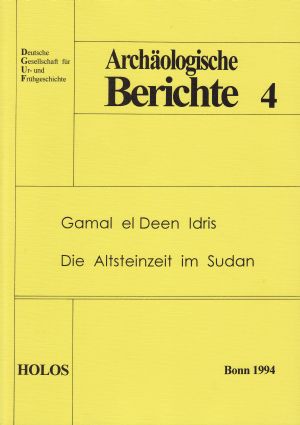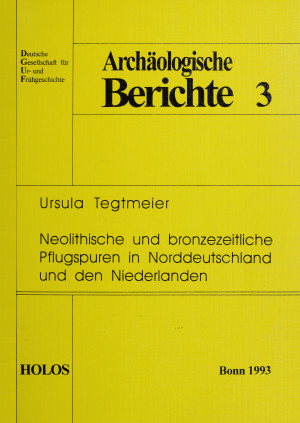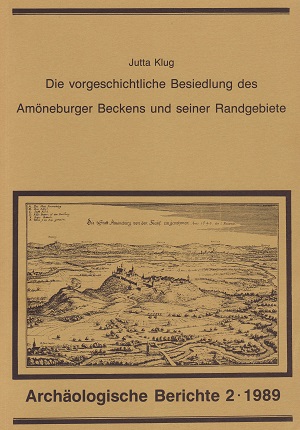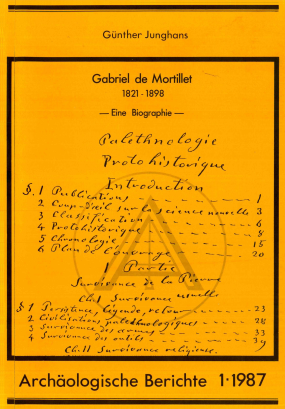Archäologische Berichte
Die „Archäologischen Berichte“ (Arch. Ber.) sind die Monografien der Deutschen Gesellschaft für Ur- und Frühgeschichte e.V. (DGUF). Sie erscheinen seit 1987 mit etwa einem Band pro Jahr. Ziel der DGUF bei der Gründung der Reihe war es, den Autoren eine Möglichkeit zu bieten, mit hoher Reichweite und wissenschaftsüblicher Qualitätssicherung preiswert und schnell publizieren zu können. Um dieses Ziel noch wirksamer erreichen zu können, erscheinen die Monografien seit Band 25 (2014) hybrid: in einer Druckausgabe und – in Kooperation mit der Universitätsbibliothek Heidelberg – zusätzlich online im Open Access. Wie die Zeitschrift der DGUF, die „Archäologischen Informationen“ nehmen auch die Monografien seit Band 25 bei Bedarf ergänzende Materialien und Open Data auf.
In einigen Bänden der Reihe wurden Arbeiten publiziert, die in der DGUF selbst entstanden sind, wie etwa die zweibändige Gedenkschrift für Wolfgang Taute (Arch. Ber. 14, 2001) oder die Literaturempfehlungen des DGUF-Arbeitskreises "Archäologie in Schule und Bildung" (Arch. Ber. 21, 2006). Die überwiegende Mehrheit der Bände entsteht jedoch aus guten Examensarbeiten und Dissertationen, die wir hier – kostengünstig für Autoren wie Leser – zeitnah zum Druck bringen. Die Werke erscheinen mit weltweiter Reichweite, gedruckt und im Open Access, samt Verlag und ISBN-Nummer in einer etablierten Reihe: Ein erheblicher Mehrwert gegenüber einer Publikation in Eigenregie, für Autoren wie für Leser.
Die Bände 1 bis 24 der Reihe wurden im Offset-Druck hergestellt, ab Band 25 erfolgt der Druck der Bücher im Print-on-Demand-Verfahren. Die noch als gedrucktes Exemplar lieferbaren Bände sind einschließlich der Preise auf der Website der DGUF ersichtlich und können bei der DGUF bestellt werden: verlag@dguf.de

Editors
Priv.-Doz. Dr. Frank Siegmund
Dr. Werner Schön
Diane Scherzler M.A.
Dr. Birgit Gehlen
Internet: Redaktionswebsite
Published so far
Excavations of Prehistoric Flint Mines at Rijckholt-St. Geertruid (Limburg, The Netherlands) by the 'Prehistoric Flint Mines Working Group' of the Dutch Geological Society, Limburg Section
From 1964 to 1972, the "Prehistoric Flint Mines Working Group" of the Dutch Geological Society, Limburg Section, conducted excavations in the Neolithic flint mine of Rijckholt-St. Geetruid. The excavations based on a nearly 150 metres long tunnel driven through the Neolithic mining area. On both sides of the tunnel, the prehistoric galleries were followed over a length of ten metres. 75 square metres of shafts and 1.526 square metres of galleries were examined on a total area of 2.436 square metres.
However, the actual mining site is significantly larger: Underground mining stretched over an area of approximately 8 hectares. Flint was mined in an area of about 25 hectares while flake was located in an 25 hectare area. The archaeologists documented all discovered shafts and galleries in detail. Furthermore, they unearthed animal bones and snail shells as well as a human skull. The excavations provided more than 14.000 artefacts. Radiocarbon dating suggested an age between 3.970 and 3.700 BC. However, the local mining activities may have lasted until 3.400 or even 2.650 BC.
The present publication describes the applied excavation methods. Moreover, it attempts to reconstruct prehistoric mining techniques. The calculation of the absolute amount of flint (14-16 million kg of an 8 hectare mining area) and the number of shafts (about 2000) suggest that the soil still contains more than 400.000 stone artefacts.
Die neolithische Besiedlung zwischen der Köln-Bonner Rheinebene und den Bergischen Hochflächen
The significance of findings in the uplands from the Neolithic Age has caused controversial discussions since the 1950s, because only stone finds, especially single finds of stone ax blades, were known. Numerous further sites were discovered over the decades. These included stone devices from the Neolithic Age that indicate the existence of settlements. With this, there is increased evidence that these finds do not stem from losses or remains of hunting patrols, nor are they artefacts (thunderbolts) that had been moved back in historical times.
In 1954 Marschall, Narr and von Uslar created a map of the Bergisches Land which included only few Neolithic archaeological sites. Since then “laymen” researchers have found hundreds of prehistoric sites the sources of which have not been evaluated yet in a summarizing manner. Of the 975 prehistoric sites that are presented in the catalogue of this work 400 of them also comprise Neolithic stone artefacts. In addition to this almost 100 single finds of flint ax blades are included.
In this archaeological landscape the author examines a transect from the Rhine Plain to the Bergische Hochflächen (Bergische Upper Plains), embeds the Neolithic finds in their chronologic and topographic contexts and links them to Mesolithic places. This results in a mid- to late-Neolithic settlement of varying intensity. The sites clearly are located where the best soil is available. In contrast, the mixed Mesolithic-Neolithic sites distinctly display a different topography where soil quality apparently seems to have been of minor relevance for the selection of respective locations. The single finds of flint axe blades that have been so controversy discussed in research history signify the close surroundings of these settlements. With this, varying and possibly complementary prehistoric economic systems become apparent.
Unter die Räder gekommen: Untersuchungen zu Sherratts "Secondary Products Revolution"
In 1981 Sherrat presented his model of a „Secondary Products Revolution“. He tried to that social and societal changes emerged in the Neolithic Period of the Old World when the usage of animal “secondary” products was introduced in the 4th millennium BC. Sherratt considers the usage of animal force (pulling of carts/ploughing and riding) as well as the production of cheese and wool as forms of these “secondary” products. As a result of his revolution he argues that two societal forms arose: on the one hand settled crop farmers and on the other hand nomadic cattle breeders who lived in conflict and symbiosis with the farmers.
Prestige - Prestigegüter - Sozialstrukturen: Beispiele aus dem europäischen und vorderasiatischem Neolithikum
Prestige and prestige goods were crucial for social processes in Neolithic societies. The sociological and cultural-anthropological term definitions in the various examples in this volume illustrate this fact: Beginning with the Levantine Aceramic, the £atal Hüyük in Anatolia and Spondylus Jewelry of the Linear Pottery culture the study leads up to the non-megalithic monuments of Denmark and the Corded Ware culture of the mid-Elbe and Saale region. In each case it is shown that, even without directly looking for “prestige goods” in the archeological material, “prestige” for certain groups of people can be reconstructed from the prehistoric sources. Neolithic societies functioned between the poles of informal prestige accumulation and regulated creation of ranks. Hierarchies are the basis for initial stratification: Social structures of the Neolithic Age become visible.
Die Keramik des frühen und hohen Mittelalters aus dem Rheinland: Stand der Forschung - Typologie, Chronologie, Warenarten
This publication originates from Andreas Heege’s Dissertation „Hambach 500 – Villa rustica und früh- bis hochmittelalterliche Siedlung bei Niederziet, Kreis Düren“ [Hambach 500 – Villa rustica and settlement of the early to high Middle Ages in Niederziet, District of Düren] completed in 1992. Since the medieval ceramics research in the Rhineland was in urgent need of a new localization and the text at hand is a completed chapter of the dissertation, the publication as such detached from the material collection of “Hambach 500” was reasonable.
Die Altsteinzeit im Sudan
In his dissertation Gamal el Deen Idris presents Paleolithic findings from Sudan that had not been mentioned in research literature until 1992. Furthermore, findings from the Sahara-expedition of the Institute for Pre- and Early History in Cologne are being described and assessed. History of research and typo-chronology constitute the main focus of this study. For interested readers the comprehensive catalogue of the sites and inventories facilitate approaching this early epoch in African regions that have been neglected to this day.
Neolithische und bronzezeitliche Pflugspuren in Norddeutschland und den Niederlanden
In her MA thesis Ursula Tegtmeier assembles the prehistoric ploughing traces from northern Germany and the Netherlands that were known until 1987. In the context of her studies she conducted ploughing experiments with her fellow students and archaeologists. The interpretation of results obtained, as well as an extensive literature survey make out integral parts of this publication. This important work is rounded off with a comprehensive catalogue.
Die vorgeschichtliche Besiedlung des Amöneburger Beckens und seiner Randgebiete
The goal of Jutta Klug’s dissertation is to indicate possibilities and limits of interpretations of settlement history based on archaeological site maps. The Amöneburger valley as a geographically closed settlement area in the Hesse Depression provides the best requirements for this study.
Maps depicting sites and findings from the Paleolithic Age until the Roman Imperial Period are presented and interpreted with regard to their possible significances for settlement history.
Gabriel de Mortillet 1821-1898: Eine Biographie
In his biography of Gabriel de Mortillets (1821-1898) Günter Junghans traces back the life and work of this versatile French scholar. This study, including the analysis of extensive original sources at the Department for Pre- and Early History at the University of Saarbrücken and the Bibliothèque Nationale in Paris, not only allows Junghans to emphasize the well-known contributions of Mortillet for research on the Paleolithic Age, but furthermore enables him to concentrate this biography on the “homme politique”.



